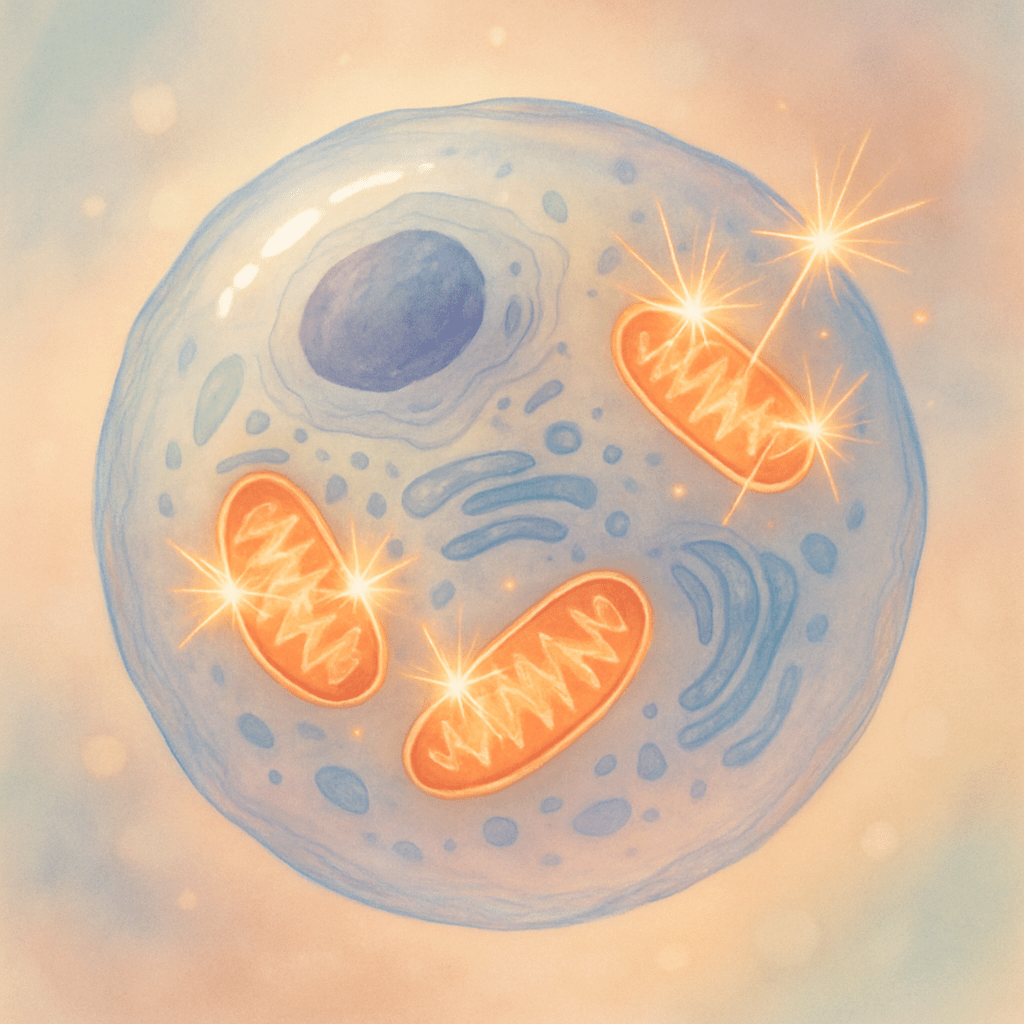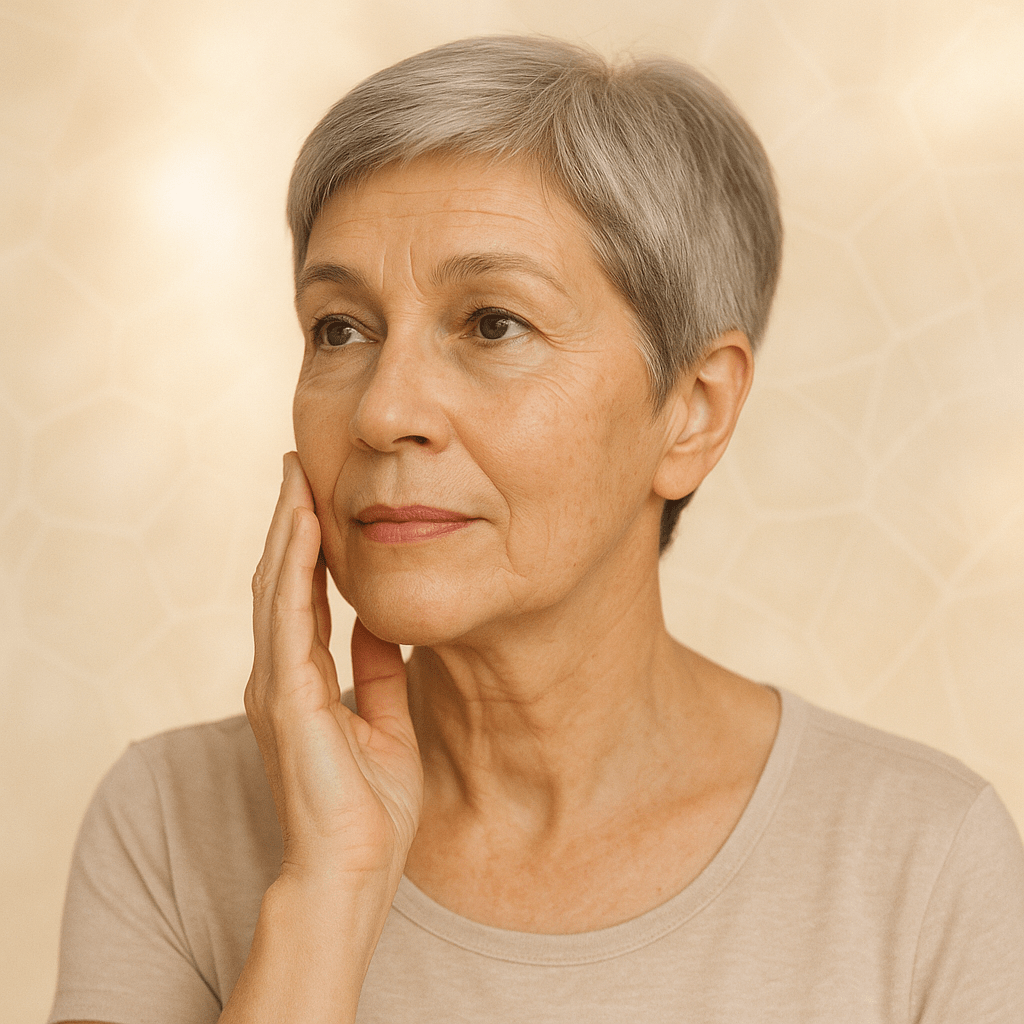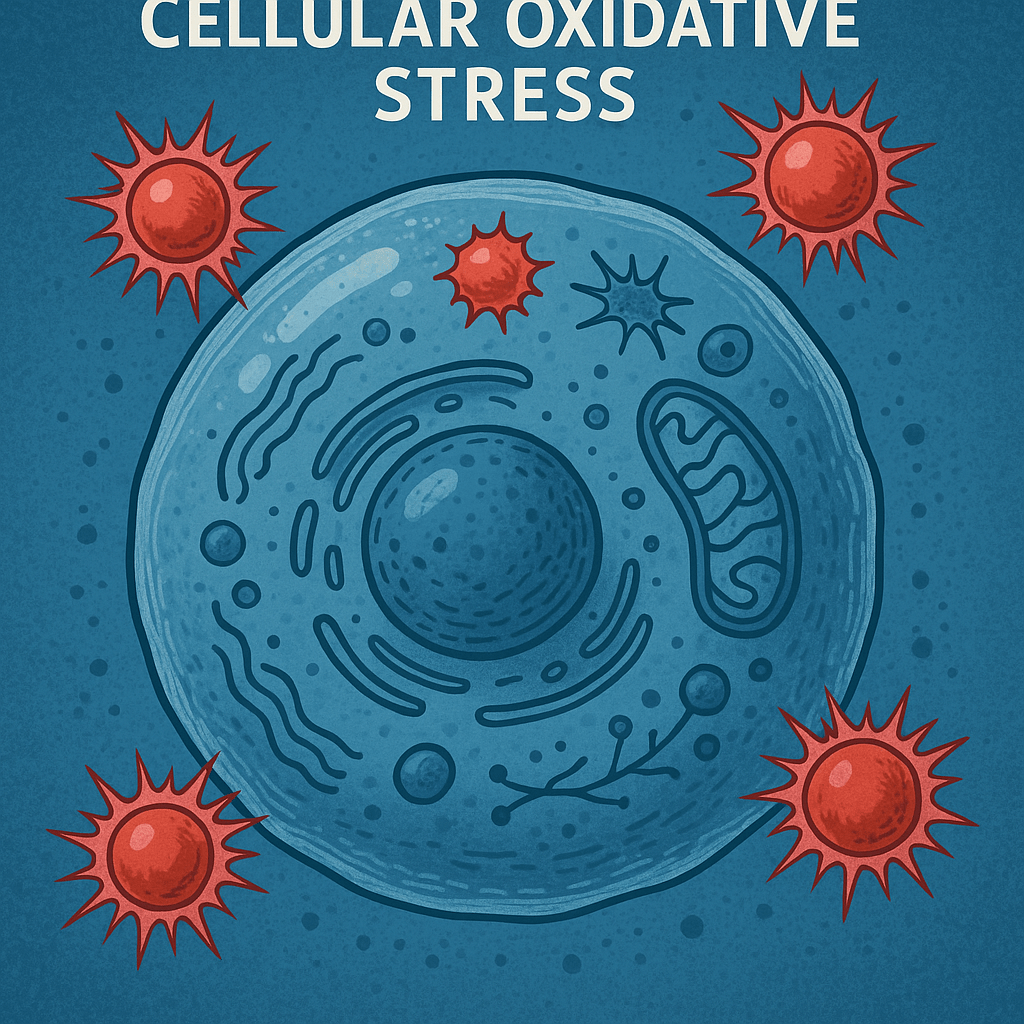Oxidative stress is a condition in which there is an imbalance between free radicals and antioxidants in the body. This imbalance can cause cellular damage and is associated with many health conditions and the aging process.

In today’s world, where environmental pollution, poor nutrition, and constant stress have become part of everyday life, the health effects of oxidative stress are receiving increasing attention from scientists and doctors. Antioxidants play a crucial role in combating this phenomenon – learn more about how Chlorella provides antioxidant protection to the body.
In this article, you will learn what exactly oxidative stress is, what its causes and mechanisms are, how it affects our health, and what are the most effective ways to protect yourself from its negative consequences. You will understand why a balanced diet, physical activity, and certain nutritional supplements are important in combating oxidative stress and maintaining long-term well-being.
Oxidative stress: causes and mechanisms
Oxidative stress occurs when the balance between reactive oxygen species (oxidants) and their neutralization mechanisms (antioxidants) is disrupted in the body. Understanding this process is essential in order to effectively take care of your health.
Free radicals are unstable molecules that have an unpaired electron and are therefore highly reactive. In order to maintain stability, they “steal” electrons from other cellular molecules, causing chain reactions that can damage cell structures, proteins, and even DNA. A certain amount of free radicals in the body is normal and even necessary for the immune system to fight pathogens, but their excess causes oxidative stress.
Oxidants are formed in the body due to both internal and external factors. Endogenous (internal) sources include natural metabolic reactions that occur in the mitochondria – the “powerhouses” of cells, where energy is produced from nutrients. Exogenous (external) sources include environmental pollution, ultraviolet rays, cigarette smoke, alcohol, certain drugs, and even certain foods.
Redox balance is the body’s ability to maintain a balance between oxidants and antioxidants. When this balance is disrupted and oxidants outnumber antioxidants, oxidative stress occurs. Research, including the work of pioneers in this field, Denham Harman, has shown that prolonged oxidative stress can lead to chronic inflammation and contribute to the development of various diseases.
Mitochondria are the main sources of free radicals in the body.

They undergo aerobic respiration, a process that produces ATP (adenosine triphosphate), the main source of energy in cells. Reactive oxygen species are released during this process. Normal functioning mitochondria have their own protective mechanisms, but various factors can disrupt their activity and increase the production of free radicals.
DNA damage due to oxidative stress is particularly dangerous because it can cause genetic mutations that can eventually contribute to the development of cancer or accelerate aging. It has been found that oxidative stress can damage up to 10,000 DNA bases per day in each human cell, although the body is able to repair most of this damage.
To help the body maintain balance, it is important to ensure a sufficient amount of antioxidants. It is worth considering Zinc – it supports the immune system and antioxidant activity as part of your daily routine.
The main health consequences of oxidative stress
Oxidative stress has a wide range of negative effects on our body, ranging from damage to cell structures to the development of serious chronic diseases. These processes may occur gradually, but their consequences can be serious.
Cellular damage is the primary result of oxidative stress. Free radicals damage cell membranes, proteins, and genetic material, disrupting normal cell function. Over time, this damage accumulates and can manifest itself in various diseases.
Cardiovascular disease is one of the most common health problems associated with oxidative stress. Free radicals promote the oxidation of low-density lipoproteins (LDL), which contributes to the development of atherosclerosis, the thickening and hardening of blood vessel walls. This process increases the risk of heart attack and stroke. According to the European Society of Cardiology, oxidative stress is one of the main risk factors for cardiovascular disease.
Neurodegenerative diseases such as Alzheimer’s, Parkinson’s, and Huntington’s diseases are also associated with oxidative stress. Brain tissue is particularly susceptible to free radical damage due to its high oxygen consumption and relatively low antioxidant content. Studies show that neuronal damage caused by oxidative stress can accelerate the development and progression of these diseases.
Inflammation and oxidative stress are closely related processes. Free radicals can activate inflammatory signaling pathways, and inflammation in turn can increase the production of free radicals, creating a vicious cycle. Chronic inflammation is the basis of many diseases, including rheumatoid arthritis, cancer, and diabetes.
The aging process is directly related to oxidative stress. According to the free radical theory of aging, proposed by Dr. Denham Harman in 1956, aging is the gradual accumulation of damage to cellular components due to the action of free radicals. This theory has received much empirical support and is today considered one of the main theories explaining aging.
Immunity is also strongly affected by oxidative stress. Although immune system cells produce free radicals as a weapon against pathogens, excessive amounts of them can damage the immune cells themselves and weaken the overall functioning of the immune system. This can increase the risk of infections and lead to autoimmune diseases.
Skin aging is one of the most visible consequences of oxidative stress.

Ultraviolet rays promote the formation of free radicals in the skin, which can lead to the degradation of collagen and elastin, proteins responsible for skin firmness and elasticity. The result of this process is wrinkles, sagging skin, and age spots.
Diabetes and metabolic syndrome are also linked to oxidative stress. Elevated blood glucose levels can increase the production of free radicals and weaken antioxidant defenses. This can contribute to the development of insulin resistance and complications of diabetes, such as neuropathy and retinopathy.
Effective ways to control and prevent oxidative stress
When fighting oxidative stress, it is important to take a comprehensive approach that includes diet, physical activity, and other aspects of lifestyle. Fortunately, research shows many effective strategies to reduce free radical levels and strengthen the body’s antioxidant defenses.
A balanced diet is the cornerstone of fighting oxidative stress.

Fruits and vegetables, especially those with bright colors, are rich in antioxidants, including vitamins C and E, beta-carotene, and various phytochemicals. It is recommended to consume at least 5 servings of a variety of fruits and vegetables daily. Here are some foods that are particularly rich in antioxidants:
dark green leafy vegetables (spinach, kale)
bright orange and red vegetables (carrots, tomatoes, red peppers)
berries (blueberries, blackberries, raspberries)
nuts and seeds (almonds, sunflower seeds)
whole grains
green and black tea
It is important not only to include foods rich in antioxidants, but also to avoid foods that increase oxidative stress: processed foods, trans fats, refined carbohydrates, and high sugar content.
For a deeper look at one of nature’s most powerful antioxidants, read about the protective effects of resveratrol.
Physical activity is a double-edged sword in terms of oxidative stress. Regular moderate-intensity exercise increases endogenous antioxidant production and improves overall body function. However, excessive exercise can temporarily increase oxidative stress. The optimal regimen is 150 minutes of moderate-intensity aerobic activity per week, supplemented with strength training 2-3 times a week.
Stress management is also very important, as psychological stress promotes the intensification of oxidative processes in the body. Meditation, yoga, deep breathing and other relaxation techniques can reduce stress hormone levels and, with it, oxidative stress.
The quality and sufficient amount of sleep (7-9 hours for adults) are essential for the body’s recovery and the functioning of antioxidant systems. Studies show that chronic sleep deprivation increases oxidative stress and inflammation.
Giving up bad habits is one of the most effective ways to reduce oxidative stress. Smoking and heavy alcohol consumption are strong sources of free radicals, so quitting or at least reducing them can significantly improve antioxidant status.
Controlling environmental factors is also important. Avoiding pollution, excess UV radiation, and chemical toxins can reduce exogenous oxidative stress.
Supplements for Extra Support
While we should get most of our antioxidants from food, sometimes we may need some extra support. The most popular antioxidant supplements include:
- Vitamin C – a powerful antioxidant that helps regenerate other antioxidants
- Vitamin E – a fat-soluble antioxidant that protects cell membranes
- Coenzyme Q10 – important for mitochondrial function
- Selenium – a mineral essential for the activity of glutathione peroxidase (an important antioxidant enzyme)
- Polyphenols – plant-based compounds with potent antioxidant properties
When extra help is needed, a high-quality Quercetin supplement (quercetin capsules) can complement a comprehensive anti-inflammatory routine.
It’s important to note that supplements should not replace a varied, antioxidant-rich diet. Additionally, it is recommended to consult a healthcare professional before taking any supplements, as in some cases, excessive doses of antioxidants can have the opposite effect, promoting oxidative stress or interfering with certain medications.
Vitamin C is one of the most popular antioxidants, but it is important not to exceed the recommended daily intake (usually 75-90 mg for adults, although higher doses may be recommended for some groups). Excessive amounts of vitamin C can cause digestive problems and kidney stones.
Antioxidant complexes can be beneficial for those who do not eat enough fruits and vegetables, but they should not be considered the only solution. Antioxidants have been shown to work better synergistically, as they occur naturally in food, than in isolated supplements.
An individualized approach to managing oxidative stress is most effective. Depending on an individual’s genetics, lifestyle, and environmental factors, different strategies may be beneficial. Consulting with a physician or nutritionist with knowledge of oxidative stress can help you create a personalized plan.
The key is to understand that combating oxidative stress should be an ongoing effort, not a short-term diet or supplement. Consistent, long-term lifestyle changes will yield the best results in reducing oxidative stress and improving overall health.
Conclusions
Oxidative stress is a complex biological process that can have a significant impact on our health and longevity. Maintaining a balance between free radicals and antioxidants is essential for healthy cellular function and overall vitality.
By understanding the mechanisms of oxidative stress and its effects on health, we can take targeted steps to reduce the risks it poses. A comprehensive approach that includes an antioxidant-rich diet, regular physical activity, effective stress management, and thoughtful use of nutritional supplements can help maintain redox balance and protect against many diseases.
It is important to remember that managing oxidative stress is a long-term commitment, not a one-time intervention. Regular health check-ups and consultation with trusted healthcare professionals should be part of this strategy, especially before making any significant dietary or supplement changes.
By investing in antioxidant health today, we are laying the foundation for a better quality of life and a longer, healthier life in the future. Remember that every small positive change has a cumulative effect, and it is never too late to start taking care of your body’s redox balance.
Frequently Asked Questions (FAQ)
What are the first signs of oxidative stress in the body?
Early signs may include fatigue, decreased immunity, skin problems (paleness, dryness) and increased susceptibility to infections. Laboratory tests are usually required for diagnosis.
What foods are naturally rich in antioxidants?
Berries (acai, goji, blueberries), leafy greens, nuts, dark chocolate and colorful vegetables are excellent sources of natural antioxidants.
Can antioxidant supplements completely replace a healthy diet?
No – supplements can help, but they cannot replace the variety of antioxidants found in a variety of natural foods.
Is oxidative stress only a problem with aging?
Although oxidative stress increases with age, young people can also experience it due to environmental stressors, poor diet, smoking or chronic diseases.

